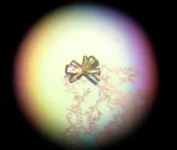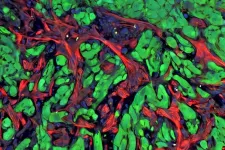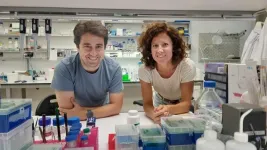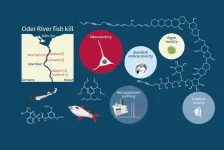(Press-News.org) The first crystal structure of an alternative DNA shape from the insulin gene has been revealed by a UCL-led research team.
DNA is widely accepted to be formed of two strands that wind around one another, known as a double helix, but it is possible for DNA to change shape and structure. The new study, published in Nature Communications, reveals the detail in the structure of a type of DNA called i-motif by crystallising it for the first time.
Co-lead author Dr Zoë Waller (UCL School of Pharmacy) said: “DNA is our genetic material, and its structure usually looks a bit like a twisted ladder called a double helix. This shape is iconic, but alternative DNA structures exist and are thought to potentially play a role in the development of genetic diseases, such as diabetes or cancer.”
The researchers were focusing on i-motif DNA, which has an interlocking structure resembling a knot, and was only confirmed to be found in living human cells in 2018.
Dr Waller said: “It was previously known that there was a region of DNA in the insulin gene that can fold into alternative DNA structures and shapes. It was also known that this region of DNA varies between people. Our work shows that these different variants in sequence fold into different DNA shapes.”
The scientists employed a crystallography technique that concentrates a solution containing the DNA, enabling crystals to form, which is an important method for researchers to see the structure of DNA using X-ray crystallography.
Dr Waller explained: “We were able to crystallise a four-stranded DNA structure, called an ‘i-motif’. Our crystals allowed us to determine exactly what the structure of this DNA looks like using X-rays. This has revealed that certain DNA sequences have special, additional interactions which help them form alternative DNA structures more easily.”
The research team demonstrated that different sequence variants in the insulin gene form different DNA structures, which in turn could affect whether insulin is switched on or off.
By demonstrating how the shape of DNA can affect insulin gene function, already known to be critical in diabetes, they hope their findings could guide future research into diabetes treatment. The crystal structure the scientists developed can enable computational-based drug discovery to be used to target the i-motifs from the insulin gene, because when scientists know the specific 3D shape, they can design molecules digitally and model them to see whether they will fit. Scientists can then develop new drugs using particular chemicals when they know which ones will fit the drug target best – a process called rational design.
As the first crystal structure of this type, the researchers say it will also be useful as a model for other targets in the genome, besides the insulin gene, which form this shape of DNA.
Dr Waller added: “This research means that now we can use the shape of DNA to design molecules to bind these structures, which could be developed into drugs and potentially medicines.”
The research was funded by Diabetes UK.
The UCL School of Pharmacy has a long history of characterisation of alternative DNA structures, from the first crystal structure of a different DNA structure called a G-quadruplex, in a 2011 study, through to showing in 2018 that the human telomere can form junctions.
END
Crystallized alternative DNA structure sheds light on insulin and diabetes
2024-09-06
ELSE PRESS RELEASES FROM THIS DATE:
Protecting just 0.7% of world’s land could help save a third of most unique and endangered species
2024-09-06
Conservation efforts directed towards just 0.7% of the world’s land mass could help protect one third of the world’s threatened and unique tetrapod (four-limbed vertebrate) species, new research by Imperial College London, On the Edge, and ZSL has shown.
The study, led by researchers at Imperial College London and published this week in Nature Communications, finds that large gains in conservation are possible by focusing on areas home to exceptional biodiversity and species with high levels of evolutionary distinctiveness and global ...
TGF-beta and RAS signaling are both required for lung cancer metastasis, study finds
2024-09-06
When it comes to cancer metastasis, it takes two to tango. That was one of the key findings of a new study led by researchers at Memorial Sloan Kettering Cancer Center (MSK): The TGF-beta and RAS signaling pathways work together to spur the spread of cancer in lung adenocarcinoma, a leading cause of cancer deaths around the world.
Take away one of those two signals, and lung cancer will not be able to spread (metastasize) to new parts of the body, their findings in animal models suggest.
The research, published September 6 in Cell, points to new opportunities to potentially prevent metastasis, thanks to an updated understanding of the underlying processes.
“About ...
5 lessons to level up conservation successfully
2024-09-06
Conservation needs to scale successfully to protect nature. A new paper takes lessons from around the world to show how that might be done.
To reverse biodiversity loss and meet ambitious global targets, conservation programmes designed to preserve everything from forests to fish need to work ‘at scale’.
Scaling can mean three things. Scaling ‘out’ means expanding a programme to new people and places, while scaling ‘up’ means bringing in higher-level institutions, such as governments introducing policies or incentives that make it easier for individuals and private companies to engage.
Scaling ‘deep’ means changing hearts and minds – ...
Researchers advance new class of quantum critical metal that could advance electronic devices
2024-09-06
A new study led by Rice University’s Qimiao Si has unveiled a new class of quantum critical metal, shedding light on the intricate interactions of electrons within quantum materials. Published in Physical Review Letters on Sept. 6, the research explores the effects of Kondo coupling and chiral spin liquids within specific lattice structures.
“The insights gained from this discovery could lead to the development of electronic devices with extreme sensitivity, driven by the unique properties of quantum-critical ...
DOE, ORNL announce opportunity to define the future of high-performance computing
2024-09-06
The U.S. Department of Energy’s (DOE) Office of Science (SC) today announced a new research and development opportunity led by Oak Ridge National Laboratory (ORNL) to advance technologies and drive new capabilities for future supercomputers. This industry research program worth $23 million, called New Frontiers, will initiate partnerships with multiple companies to accelerate the R&D of critical technologies with renewed emphasis on energy efficiency for the next generation of post-exascale computing in the 2029 ...
Cannabidiol demonstrated to alleviate symptoms of Leigh syndrome
2024-09-06
A study led by the UAB Institut de Neurociències and published in the journal Nature Communications demonstrates in animal models how daily administration of cannabidiol (CBD), a substance obtained from the cannabis plant, extends lifespan and improves symptoms associated with Leigh syndrome. This severe mitochondrial disease affecting children is characterised by a progressive decline in cognitive and motor functions and premature death. The research group also demonstrated in both mice and fibroblasts from children with ...
A chemical cocktail of micropollutants amplified the effect of algal toxins causing mass fish mortality on the River Oder in 2022
2024-09-06
Summer 2022’s environmental disaster led to the death of up to 60 per cent of fish biomass and up to 85 per cent of mussel and snail biomass in the River Oder. In August 2022, the UFZ set up an interdisciplinary ad hoc working group together with researchers from the Leibniz Institute of Freshwater Ecology and Inland Fisheries (IGB), the University of Veterinary Medicine, Vienna (Vetmeduni) and the University of Birmingham. They took water samples at five locations along the Oder, extracted poisoned ...
Generative AI in cancer imaging: revolutionizing detection & diagnosis
2024-09-06
“This editorial explores its impact on expanding datasets, improving image quality, and enabling predictive oncology.”
BUFFALO, NY- September 6, 2024 – A new editorial was published in Oncotarget's Volume 15 on September 4, 2024, entitled, “Generative AI in oncological imaging: Revolutionizing cancer detection and diagnosis.”
Generative AI is revolutionizing oncological imaging, enhancing cancer detection and diagnosis. This editorial explores its impact on expanding ...
Disparity in access to medications for opioid use disorder persist in criminal legal settings
2024-09-06
EMBARGOED FOR RELEASE UNTIL 11 A.M. ET FRIDAY, SEPTEMBER 6. 2024
Individuals involved in the criminal legal system have a high rate of opioid use disorder (OUD) and a high risk of overdose death compared to the general population, yet the most effective treatments—medications for opioid use disorder (MOUD)—are underutilized in criminal legal settings where treatment is mandated as part of a person’s probation or parole. Medications are often not provided due to stigma or lack of adequate funding for evidence-based care. According to a study ...
Age-related changes in male fibroblasts increase treatment-resistant melanoma
2024-09-06
Age-related changes in the fibroblasts, cells that create the skin’s structure, contribute to the development of aggressive, treatment-resistant melanoma in males, according to research in mice by the Johns Hopkins Kimmel Cancer Center.
The study was published online Sept. 6 in Cell.
The risk of developing melanoma, a potentially deadly skin cancer, increases with age. Men are more at risk than women, and tend to develop more aggressive, hard-to-treat melanomas, particularly at advanced ages, says Ashani Weeraratna, Ph.D., the Bloomberg ...











